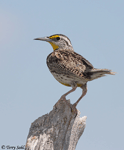Eastern Meadowlark
Sturnella magna
| Length: 9 to 11 inches | Wingspan: 14 to 17 inches | Seasonality: Summer |
| ID Keys: Black "V" on yellow breast, white outer tail feathers (most obvious in flight), brownish upperparts streaked with tan and black, light face with black stripe behind eye | ||
 The Eastern Meadowlark is nearly identical in appearance to the Western
Meadowlark. The two species are best differentiated by range and by
voice. The Western Meadowlark is
by far the more common of the two species in South Dakota, with the Eastern
Meadowlark only normally found in the extreme south-central part of the state
LaCreek National Wildlife Refuge is where they can most reliably be seen in the
state. Hybrids between the two species can occur where their ranges
overlap.
The Eastern Meadowlark is nearly identical in appearance to the Western
Meadowlark. The two species are best differentiated by range and by
voice. The Western Meadowlark is
by far the more common of the two species in South Dakota, with the Eastern
Meadowlark only normally found in the extreme south-central part of the state
LaCreek National Wildlife Refuge is where they can most reliably be seen in the
state. Hybrids between the two species can occur where their ranges
overlap.
Habitat: Found in a variety of open habitats, including prairies, meadows, weedy pastures, hay fields, and other open areas.
Diet: Primarily feeds on insects, especially during the summer months when insects may make up nearly the entire diet. They will also feed on seeds and waste grain, especially during winter months.
Behavior: Forages by walking along the ground, plucking food items from the ground or from low vegetation. Sometimes quite gregarious in the winter.
Nesting: May and June
Song: A clear whistling devoid of the Western Meadowlark's bubbling. Click here to listen to the Eastern Meadowlark's song. Click here to listen to the Eastern Meadowlark's call.
Migration: They are permanent residents throughout much of their range. However, birds at the northern end of their range do generally move southward for the winter.
Interactive eBird Map: Click here to access an interactive eBird map of Eastern Meadowlark sightings
Similar Species: Western Meadowlark
Conservation Status: Due to its dependence on open habitats, the Eastern Meadowlark was probably at much higher populations during the 1800s when much of the eastern U.S. forest land was cleared for agriculture. As marginal agricultural land has been allowed to revert back to forest, Eastern Meadowlark numbers have declined. Numbers are still in decline throughout much of the East.
Further Information: 1) USGS Patuxent Bird Identification InfoCenter, Eastern Meadowlark
2) WhatBird - Eastern Meadowlark
3) Audubon Guide - Eastern Meadowlark
Photo Information: July 5th, 2010 - LaCreek National Wildlife Refuge, South Dakota - Terry Sohl
| Click on the map below for a higher-resolution view |
 |
| South Dakota Status: Uncommon summer breeder in the extreme south-central part of the state, on the northern edge of the Sand Hills. Accidental elsewhere in the southern part of the state. |
Additional Eastern Meadowlark Photos

